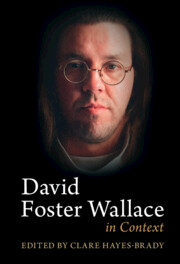Book contents
- David Foster Wallace in Context
- David Foster Wallace in Context
- Copyright page
- Contents
- Figures
- Contributors
- Acknowledgments
- Abbreviations
- Introduction
- Part I Contexts
- Part II Ideas
- Chapter 10 David Foster Wallace and Attention
- Chapter 11 After Analysis
- Chapter 12 Perfectionism and the Ethics of Failure
- Chapter 13 The Pragmatist Possibility in David Foster Wallace’s Writings
- Chapter 14 A Tale of Two Theses
- Chapter 15 Free Will and Determinism
- Chapter 16 David Foster Wallace’s Mathematics of the Infinite
- Chapter 17 David Foster Wallace and Existentialism
- Chapter 18 David Foster Wallace and Religion
- Chapter 19 Mr. Consciousness
- Part III Bodies
- Part IV Systems
- Works by David Foster Wallace
- Bibliography of Secondary Sources
- Index
Chapter 18 - David Foster Wallace and Religion
from Part II - Ideas
Published online by Cambridge University Press: 18 November 2022
- David Foster Wallace in Context
- David Foster Wallace in Context
- Copyright page
- Contents
- Figures
- Contributors
- Acknowledgments
- Abbreviations
- Introduction
- Part I Contexts
- Part II Ideas
- Chapter 10 David Foster Wallace and Attention
- Chapter 11 After Analysis
- Chapter 12 Perfectionism and the Ethics of Failure
- Chapter 13 The Pragmatist Possibility in David Foster Wallace’s Writings
- Chapter 14 A Tale of Two Theses
- Chapter 15 Free Will and Determinism
- Chapter 16 David Foster Wallace’s Mathematics of the Infinite
- Chapter 17 David Foster Wallace and Existentialism
- Chapter 18 David Foster Wallace and Religion
- Chapter 19 Mr. Consciousness
- Part III Bodies
- Part IV Systems
- Works by David Foster Wallace
- Bibliography of Secondary Sources
- Index
Summary
Wallace “dabbled in religion,” as Matthew Gilbert put it in a 1997 interview with the author, but while he was openly intrigued by it, Wallace eschewed organized religion. Much of his work is characterized by a search for meaning that in other circumstances or periods would have constituted religious questing, and the absence of belief is generally portrayed in his work as part of the malaise of contemporary life. Religious language permeates the corpus, and religious iconography plays a significant role in several texts. Belief as a good in itself appears to be promoted in his work on politics, on aesthetics, and on culture, with the idea of faith central to his project of working against solipsism, but religion as a practice is often viewed with suspicion. This essay traces that pattern in Wallace’s writing, beginning with Broom’s connection of evangelical religion with capitalism by way of the G.O.D and the figure of John, the wasted prophet son of immense wealth, positioning a particularly American form of religious practice as pernicious and profit-driven. Don’s particular ambivalence about religion in Infinite Jest highlights a complex relationship between faith as a personal attribute and religion as a collective one. The essay argues that Wallace’s approach to religious thought bears the same ambivalent inflections as his work on art and entertainment, which can both inspire thought and suppress it. Nevertheless, the essay argues that while Wallace appeared to view organized religion with some wariness, the metanarratives of religion – belief, faith, transcendence and a sense of the sacred – constitute vital and consistent themes of his craft.
Keywords
- Type
- Chapter
- Information
- David Foster Wallace in Context , pp. 192 - 202Publisher: Cambridge University PressPrint publication year: 2022



